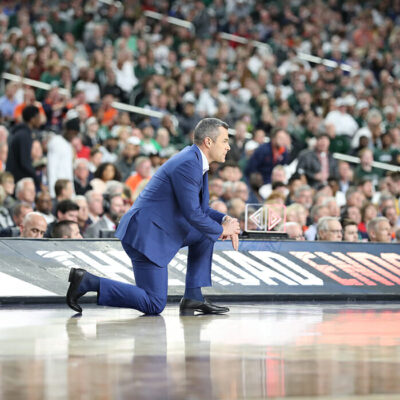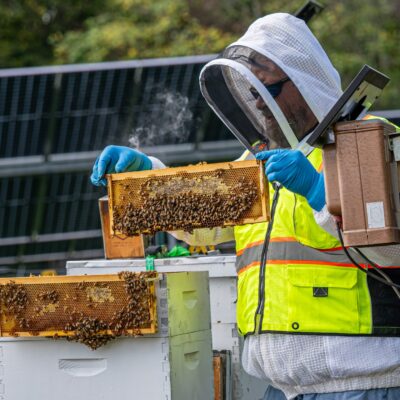Hey you: “Cheer on.”
Cut into a tacky wood plaque that Patrick Costello found in a thrift shop, this almost bossy phrase presides over The Garage this month and wryly sums up the theme of his latest work. Namely, the abstractions within Costello’s prints and paintings charge passers-by to put a little zest into their lives, despite living in a world where most problems are too big for any one person to fix.
|
“The Things We Do To Make Do,” (detail) a work in acrylic on paper by Patrick Costello, on view at The Garage through October 31. |
Take the environment. In “The Things We Do To Make Do,” black tendrils ooze like groping hands from frames of a quilt-patterned print, alluding to the BP oil disaster that weighed on the artist’s mind at the time. Yet even as Costello conjures a subject as hopeless as rounding up almost 5 million barrels of crude in the Gulf, the piece also alludes to planting, gardening and canning.
“Gardening is definitely something that provides a starting point for a lot of my work,” says the 24-year-old artist and co-owner of C’ville Foodscapes. Local produce obviously won’t do anything to lessen environmental catastrophe elsewhere. But the art tells us that small, local steps to make the world better can be worthwhile and redemptive all the same.
Whether or not the casual visitor engages with the subtle advocacy of Costello’s images, viewers are likely to find his geometric designs and offbeat sculpture appealing in their own right. His prints borrow from the hypnotic patterns of heirloom quilts and color spectrums. His geometric designs, repetitive images, or his jars, hands and kale manage to grab the eye, in spite of the two-dimensional constraints imposed by screen printing or the letterpress he uses at Virginia Arts of the Book Center.
Adding further to the show’s originality, two prints are mounted atop roughly 3′ tall paintings of dung. In another homage to gardening, the light and earthy browns against a cow-plop-shaped sheet of plywood almost manage to look appealing, just as they would to a gardener about to juice some topsoil with natural fertilizer.
Not one to let a single look define his work, Costello’s largest piece in the exhibit consists of a small wood building topped with moss. (Fun fact: You can order live moss online, Costello says, and he plans to plant it when the exhibit ends.) Hewing to the artist’s fondness for familiar local materials, the structure’s recycled wood includes discarded letter-press trays from VABC and old drawing racks from the UVA art department. At the back of the shed, rows of local produce in jars create another warm color spectrum lit by lamps made by Costello’s grandfather from old flowerpots and plastic beads.
“Rather than run away from nostalgia, I’m pretty into it,” Costello says.
The artist adds that he wanted the sculpture to simultaneously evoke the feelings one associates with an outhouse, a bomb shelter and a root cellar. Like the bulk of his work in “Cheer On,” the sculpture alludes both to the unpleasant uncertainties of the broader world, as well as comfort offered by the resources all around us.






